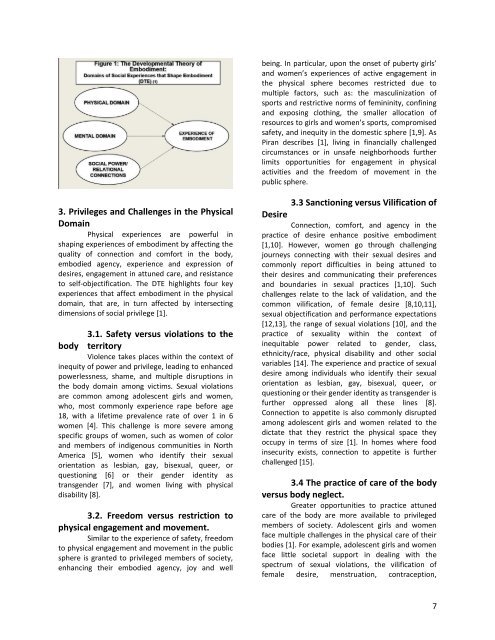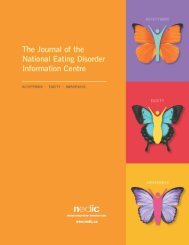NEDIC Conference Journal 2018
You also want an ePaper? Increase the reach of your titles
YUMPU automatically turns print PDFs into web optimized ePapers that Google loves.
eing. In particular, upon the onset of puberty girls’<br />
and women’s experiences of active engagement in<br />
the physical sphere becomes restricted due to<br />
multiple factors, such as: the masculinization of<br />
sports and restrictive norms of femininity, confining<br />
and exposing clothing, the smaller allocation of<br />
resources to girls and women’s sports, compromised<br />
safety, and inequity in the domestic sphere [1,9]. As<br />
Piran describes [1], living in financially challenged<br />
circumstances or in unsafe neighborhoods further<br />
limits opportunities for engagement in physical<br />
activities and the freedom of movement in the<br />
public sphere.<br />
3. Privileges and Challenges in the Physical<br />
Domain<br />
Physical experiences are powerful in<br />
shaping experiences of embodiment by affecting the<br />
quality of connection and comfort in the body,<br />
embodied agency, experience and expression of<br />
desires, engagement in attuned care, and resistance<br />
to self-objectification. The DTE highlights four key<br />
experiences that affect embodiment in the physical<br />
domain, that are, in turn affected by intersecting<br />
dimensions of social privilege [1].<br />
3.1. Safety versus violations to the<br />
body territory<br />
Violence takes places within the context of<br />
inequity of power and privilege, leading to enhanced<br />
powerlessness, shame, and multiple disruptions in<br />
the body domain among victims. Sexual violations<br />
are common among adolescent girls and women,<br />
who, most commonly experience rape before age<br />
18, with a lifetime prevalence rate of over 1 in 6<br />
women [4]. This challenge is more severe among<br />
specific groups of women, such as women of color<br />
and members of indigenous communities in North<br />
America [5], women who identify their sexual<br />
orientation as lesbian, gay, bisexual, queer, or<br />
questioning [6] or their gender identity as<br />
transgender [7], and women living with physical<br />
disability [8].<br />
3.2. Freedom versus restriction to<br />
physical engagement and movement.<br />
Similar to the experience of safety, freedom<br />
to physical engagement and movement in the public<br />
sphere is granted to privileged members of society,<br />
enhancing their embodied agency, joy and well<br />
3.3 Sanctioning versus Vilification of<br />
Desire<br />
Connection, comfort, and agency in the<br />
practice of desire enhance positive embodiment<br />
[1,10]. However, women go through challenging<br />
journeys connecting with their sexual desires and<br />
commonly report difficulties in being attuned to<br />
their desires and communicating their preferences<br />
and boundaries in sexual practices [1,10]. Such<br />
challenges relate to the lack of validation, and the<br />
common vilification, of female desire [8,10,11],<br />
sexual objectification and performance expectations<br />
[12,13], the range of sexual violations [10], and the<br />
practice of sexuality within the context of<br />
inequitable power related to gender, class,<br />
ethnicity/race, physical disability and other social<br />
variables [14]. The experience and practice of sexual<br />
desire among individuals who identify their sexual<br />
orientation as lesbian, gay, bisexual, queer, or<br />
questioning or their gender identity as transgender is<br />
further oppressed along all these lines [8].<br />
Connection to appetite is also commonly disrupted<br />
among adolescent girls and women related to the<br />
dictate that they restrict the physical space they<br />
occupy in terms of size [1]. In homes where food<br />
insecurity exists, connection to appetite is further<br />
challenged [15].<br />
3.4 The practice of care of the body<br />
versus body neglect.<br />
Greater opportunities to practice attuned<br />
care of the body are more available to privileged<br />
members of society. Adolescent girls and women<br />
face multiple challenges in the physical care of their<br />
bodies [1]. For example, adolescent girls and women<br />
face little societal support in dealing with the<br />
spectrum of sexual violations, the vilification of<br />
female desire, menstruation, contraception,<br />
7




